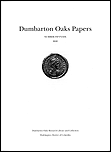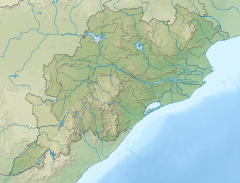
Brahmani or Brahmi, is one of the seven Hindu mother goddesses known as Sapta Matrikas. She is a form of Saraswati and is considered as the Shakti of the creator god Brahma in Hinduism. She is an aspect of Adi Shakti, possessing the "Rajas Guna" and is therefore the source of Brahma's power.

The Brahmani is a major seasonal river in the Odisha state of eastern India. The Brahmani is formed by the confluence of the Sankh and South Koel rivers, and flows through the districts of Sundargarh, Deogarh, Angul, Dhenkanal, Cuttack, Jajapur and Kendrapara. Also South Koel can be considered as upper reaches of Brahmani. Together with the river Baitarani, Brahmani forms a large delta before emptying into the Bay of Bengal at Dhamra. It is the second widest river in Odisha after Mahanadi.

The Mahājanapadas were sixteen kingdoms or oligarchic republics that existed in ancient India from the sixth to fourth centuries BCE during the second urbanisation period.

Bamra State or Bamanda State, covering an area of 5149 km2, was one of the princely states of India during the period of the British Raj, its capital was in Debagarh (Deogarh). Bamra State acceded to India in 1948.

The Baitarani is one of six major rivers of Odisha, India. Venerated in popular epics and legends, the Baitarani River is a source of water for agricultural irrigation. The coastal plain of Odisha has the name of "Hexadeltaic region" or the "Gift of Six Rivers". These deltas divide the coastal plain into three regions from north to south. The Baitarani, the Mahanadi and the Brahmani rivers form the Middle Coastal Plain, with evidence of past "back bays" and present lakes.
Khalghat is a small town and a gram panchayat in Dhar district in the state of Madhya Pradesh, India. It is located on the north bank of the Narmada, at an important ford where the Agra-Bombay national highway crosses the river. Hindi and Nimadi and Malvi are the primary languages spoken in the area.

Dumbarton Oaks Papers (DOP) is an academic journal founded in 1941 under the auspices of the Dumbarton Oaks Research Library and Collection for the publication of articles relating to Byzantine society and culture from the 4th to 15th century in the Roman Empire as well as its neighboring and successor states. The journal treats sources in medieval Greek, as well as other premodern languages, such as Arabic, Armenian, Coptic, Ethiopic, Georgian, Latin, Old Church Slavonic, and Syriac. Submissions address a range of topics, including art and iconography, architecture, archaeology, codicology, epigraphy, history, historiography, language, law, literature, music, numismatics, palaeography, science, sigillography, and theology.
The koel is a genus of birds.

Odisha is one of the 28 states in the Republic of India. Odisha is located in the eastern part of the Indian peninsula and the Bay of Bengal lies to its East while Chhattisgarh shares its border in the west and north-west. The state also shares geographic boundaries with West Bengal in the north-east, Jharkhand in the north and Andhra Pradesh in the south. The state is spread over an area of 1,55,707 km2 and extends for 1030 km from north to south and 500 kilometres from east to west. Its coastline is 450 km long. The state is divided into 30 districts which are further subdivided into 314 blocks.

South Koel River is a 285 kilometres (177 mi) long river which runs across Jharkhand and Odisha states in India. It originates on the Lawapani Waterfalls, near Lohardaga, Chota Nagpur Plateau a Lawapani Waterfalls, near Lohardaga, Chota Nagpur Plateau 82.5 kilometres (51 mi) from Ranchi, and conjoins the Belsiangar and Singbhum Rivers. The Koel is fed by three streams in Jharkhand, namely the North Karo, South Karo and Koina. The South Koel enters Odisha and joins with Sankh River at Vedavyas near Rourkela from where it is named as Brahmani.

The Brahmani River is a tributary of the Dwarka River.

Jaora State was a 13 gun-salute princely state of the British Raj. It was part of the Malwa Agency.

Cuttack railway station is a railway junction and serves Cuttack in the Indian state of Odisha.

The Pathans of Madhya Pradesh are an Urdu-speaking Pashtun community settled in the present-day Indian state of Madhya Pradesh as well as a small minority of internal migrants and their descendants in neighbouring Chhattisgarh state, which was partitioned in 2000.
Upendranath College is located in Soro, Balasore district, Odisha, India. The college was founded in 1964. It is located near NH-5. The Higher Secondary courses are affiliated to Council of Higher Secondary Education, Odisha and Graduation courses are affiliated to Fakir Mohan University. Arts Degree started in 1966, Commerce in 1978 and Science in 1980.
Dr. Shridhar Vasudev Sohoni (1914–2002) was an eminent scholar of Sanskrit, and a noted antiquarian and numismatist. He was an officer in the Indian Civil Service, and later in his career served as the Chief Secretary of Bihar, Lokayukta of Bihar, and the Vice-Chancellor of Lalit Narayan Mithila University and Tilak Maharashtra University. As a scholar, he published extensively and authored and edited several books and essays on a variety of subjects, including archaeology, architecture, Buddhism, literature, music, Sanskrit, sculpture, and administration. Dr. S.V. Sohoni was honoured with many awards and a festscrift recognised him as one of the founders of the Academy of Indian Numismatics and Sigillography. A festschrift celebrating his Sanskrit scholarship had already been published a decade earlier. He was conferred D.Litt. degrees by four institutions, University of Delhi, Vikram University, Lalit Narayan Mithila University, and Nalanda University.

The Sasanian coinage of Sindh refers to a series of Sasanian-style issues, minted from 325 to 480 CE in Sindh, in the southern part of modern Pakistan, with the coin type of successive Sasanian Empire rulers, from Shapur II to Peroz I. Together with the coinage of the Kushano-Sasanians, these coins are often described as "Indo-Sasanian". They form an important part of Sasanian coinage.

Indo-Sasanian coinage was major type of coinage of the post-Gupta Empire period, in the areas of Gujarat and Rajasthan in western India and in the Gangetic region, from the 6th century to the 12th century CE. These coins were derived from the Sasanian coinage design, probably transmitted to the subcontinent by the Alchon Huns as they invaded northern India circa 500 CE. They are an important component of Indian coinage.













